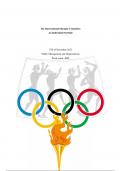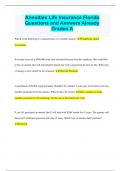The International Olympic Committee
An Individual Portfolio
17th of December 2023
Public Management and Organisations
Word count: 4000
,Introduction
The International Olympic Committee (IOC) lies at the heart of global sport. It is an
international non-profit organization with ambitions and idealistic objectives since its
conception, aiming to use sports as a tool for peace (Chappelet & Mabbott, 2008, p.179).
Founded in 1894 in Lausanne, Switzerland, the IOC revived the Olympic Games and the
philosophy of Olympism. Today, the IOC is the supreme authority overseeing the celebration
of the Olympic Games, assigning responsibilities to commissions operating as outsourcing
entities. The global organization supervises the entire Olympic Movement, with a wide span
of control and a transnational chain of command. They collaborate with various stakeholders
ranging from the 205 National Olympic Committees (NOCs), and the International Sports
Federations (IF) to the Organizing Committees of the Olympic Games (OCOGs), along with
other internal commissions designed to meet external demands (International Olympic
Committee, 2023; Gafner, 1994, p.44).
In pursuing this mission, the organization is departmentalized into three branches – the
Executive Board, the Commissions, and the IOC members. The Executive Board comprises
the “President, four Vice-Presidents, and ten other members,” elected by the Session, an
annual general meeting, in a secret ballot (Olympic Charter, 2023, Rule 19:1-2.1). They hold
managerial positions with legislative work tasks that consist of monitoring the Olympic
Charter and administratively assisting specific commission departments (Olympic Charter,
2023, Rule 19:3). The president can lead proposals, but decision-making occurs under the
IOC Executive Board's voting system (Olympic Charter, 2023, Bye-law to Rule 19:4).
The 29 Commissions, formed by the President, are highly specialized to inform the Executive
Board and serve the vision of the Olympic Charter – the regulatory framework that all
stakeholders within the Olympic Movement must adhere to (Olympic Charter, 2023, Rule
21). The 115 IOC members are IOC representatives promoting Olympic ideals in their
nations (Olympic Charter, 2023, Rule 16). This departmentalization and the wide span of
control showcase a decentralized and divisional structure. Staff members are, therefore,
organized into the services their departments supply, and they enjoy greater independence
under the general guidance of the Olympic Charter.
1
, In essence, the IOC is an international non-profit organization that acts as the supreme
authority over the Olympic Movement and equally concerns the arrangement of the Olympic
Games and the promotion of Olympism, which “evokes values such as peace, fraternity, and
fair play” (Chappelet & Mabbott, 2008, p.37). The structure of the IOC as was described in
the Introduction is outlined and illustrated in Figure 1. The organization has a divisional
structure that facilitates distributed leadership under the guidance of the Olympic Charter,
which showcases strict formalization. This structure has largely remained intact for several
years, with some alterations on the IOC’s members' interaction with candidate countries after
the infamous corruption scandals associated with the Olympic Winter Games in Salt Lake
City in 2002, where the IOC expelled six members for taking hundreds of thousands of
dollars from influential officials that brought the Winter Olympic Games to Salt Lake City in
2002 (Siddons, 1999, March 17). Nonetheless, this measure did not entirely remove
corruption. With the latter in mind, this individual portfolio examines the degree of
publicness associated with the organization, along with a policy memo on the organization’s
performance, and finally analyzes the current leadership style and provides recommendations
for new leadership approaches.
Figure 1 - Structure of the IOC as illustrated in the Introduction
2







